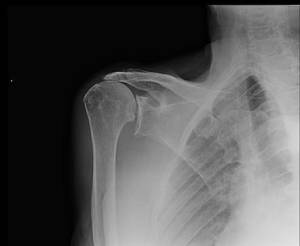Rotator Cuff Syndrome
A specific pattern of shoulder degenerative joint disease that results from
- rotator cuff tears leading to loss of joint congruence
- results in abnormal glenohumeral wear
- leads to the specific pattern of degenerative joint disease
Rotator cuff arthropathy is characterized by the combination of
- rotator cuff insufficiency
- glenohumeral cartilage destruction
- superior migration of the humeral head
- subchondral osteoporosis
- humeral head collapse
Clinical
Inspection & palpation
- supraspinatus/infraspinatus atrophy
- prominence of humeral head anteriorly (anterosuperior escape) with elevation of arm
- subcutaneous effusion from loss of fluid from capsule
Range of motion
- limitations in active and passive ROM
- crepitus in glenohumeral and/or subacromial joints with ROM
- pseudoparalysis - inability to abduct shoulder
Provocation tests
external rotation lag sign
- inability to maintain passively externally rotated shoulder with elbow at 90o - consistent with a massive infraspinatus tear
Hornblower sign
- inability to externally rotate or maintain passive external rotation of a shoulder placed in 90o of elbow flexion and 90o of shoulder abduction - consistent with teres minor dysfunction
Management
- physiotherapy with a scapular and rotator cuff strengthening exercises
- non-steroidal anti-inflammatories
- subacromial steroid injections - some trials suggest no benefit over NSAIDs and also have risk of increasing degeneration of soft tissues including ligaments and tendons here.
- surgical
